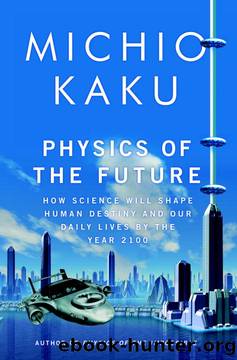Physics of the Future: How Science Will Shape Human Destiny and Our Daily Lives by the Year 2100 by Dr. Michio Kaku

Author:Dr. Michio Kaku [Kaku, Michio]
Language: eng
Format: epub
Publisher: Random House
Published: 2011-03-14T16:00:00+00:00
QUANTUM COMPUTERS
The most ambitious proposal is to use quantum computers, which actually compute on individual atoms themselves. Some claim that quantum computers are the ultimate computer, since the atom is the smallest unit that one can calculate on.
An atom is like a spinning top. Normally, you can store digital information on spinning tops by assigning the number â0â if the top is spinning upward, or â1â if the top is spinning down. If you flip over a spinning top, then you have converted a 0 into a 1 and have done a calculation.
But in the bizarre world of the quantum, an atom is in some sense spinning up and down simultaneously. (In the quantum world, being several places at the same time is commonplace.) An atom can therefore contain much more information than a 0 or a 1. It can describe a mixture of 0 and 1. So quantum computers use âqubitsâ rather than bits. For example, it can be 25 percent spinning up and 75 percent spinning down. In this way, a spinning atom can store vastly more information than a single bit.
Quantum computers are so powerful that the CIA has looked into their code-breaking potentials. When the CIA tries to break the code of another nation, it searches for the key. Nations have devised ingenious ways of constructing the key that encodes their messages. For example, the key may be based on factorizing a large number. Itâs easy to factorize the number 21 as the product of 3 and 7. Now letâs say that you have an integer of 100 digits, and you ask a digital computer to rewrite it as the product of two other integers. It might take a digital computer a century to be able to factorize this number. A quantum computer, however, is so powerful that in principle it can effortlessly crack any such code. A quantum computer quickly outperforms a standard computer on these huge tasks.
Quantum computers are not science fiction but actually exist today. In fact, I had a chance to see a quantum computer for myself when I visited the MIT laboratory of Seth Lloyd, one of the pioneers in the field. His laboratory is full of computers, vacuum pumps, and sensors, but the heart of his experiment is a machine that resembles a standard MRI machine, except much smaller. Like the MRI machine, his device has two large coils of wire that create a uniform magnetic field in the space between them. In this uniform magnetic field, he places his sample material. The atoms inside the sample align, like spinning tops. If the atom points up, it corresponds to a 0. If it points down, it corresponds to a 1. Then he sends an electromagnetic pulse into the sample, which changes the alignment of the atoms. Some of the atoms flip over, so a 1 becomes a 0. In this way, the machine has performed a calculation.
So why donât we have quantum computers sitting on our desks, solving the mysteries
Download
This site does not store any files on its server. We only index and link to content provided by other sites. Please contact the content providers to delete copyright contents if any and email us, we'll remove relevant links or contents immediately.
Sapiens: A Brief History of Humankind by Yuval Noah Harari(13038)
Sapiens by Yuval Noah Harari(4529)
Homo Deus: A Brief History of Tomorrow by Yuval Noah Harari(4272)
Pale Blue Dot by Carl Sagan(3996)
Origin Story: A Big History of Everything by David Christian(3133)
Livewired by David Eagleman(3115)
Brief Answers to the Big Questions by Stephen Hawking(2873)
Inferior by Angela Saini(2829)
Origin Story by David Christian(2677)
The Evolution of Beauty by Richard O. Prum(2550)
Signature in the Cell: DNA and the Evidence for Intelligent Design by Stephen C. Meyer(2496)
The Gene: An Intimate History by Siddhartha Mukherjee(2488)
Aliens by Jim Al-Khalili(2376)
How The Mind Works by Steven Pinker(2207)
Sex at Dawn: The Prehistoric Origins of Modern Sexuality by Ryan Christopher(2148)
From Bacteria to Bach and Back by Daniel C. Dennett(2146)
A Short History of Nearly Everything by Bryson Bill(2131)
Endless Forms Most Beautiful by Sean B. Carroll(2080)
Who We Are and How We Got Here by David Reich(2057)
